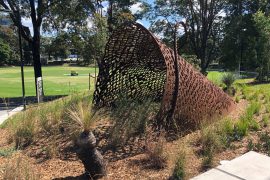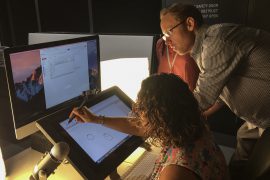As we approach the beginning of semester 2 and dust off our chalk (or whiteboard markers or PowerPoint files), it’s a key time to examine the significant impact that we, as educators, have on our students’ mental health and wellbeing. And more importantly – what we can do to as part of our teaching and curriculum design to have a positive influence.
A study out of the University of Melbourne, published earlier this year, highlighted the higher proportion of students in higher education (relative to the general population) who report psychological distress and symptoms of anxiety and depression. In order to address this, they asked thousands of students: “What can be done to improve student wellbeing?” Over two-and-a-half thousand students provided recommendations to this question, which were found to fall into seven broad categories (% of total recommendations is shown in parentheses):
- academic teachers and teaching practices (37.2%);
- student services and support (27.3%);
- environment, culture, and communications (24.7%);
- course design (15.5%);
- program administration (11.3%);
- assessment (10.1%); and
- student society activities (9.3%).
Being a blog mainly about learning and teaching, we’ll focus here on the most prevalent theme identified by students, and consider what we can do as educators to better support students.
Academic teachers and teaching practices
The paper reported that “teachers’ attributes such as approachability and empathy, and their communication skills” strongly impacted student wellbeing, as well as “how teachers facilitated and fostered interaction, both teacher-student interactions and peer interaction”. Students also identified their desire for teachers to improve student engagement through diversitying their teaching approaches, as well as enhancing the level of individualised support for student learning. The authors concluded that students’ recommendations about what teachers could do were consistent with well-established practices of ‘good teaching’, and that teachers had a critical role to play, as part of this, in fostering student wellbeing.
“This is not to say that academics need to become mental health experts… Instead, our analysis reveals that most students’ recommendations were appropriately related to fundamental teacher attributes and skills.”
In order to practically help teachers do this the same authors, as part of a national team, have published a very helpful and practical handbook on improving student mental health and wellbeing. There, they highlight five ‘wellbeing essentials’ – evidence-backed principles that underlie the connection between good teaching practices and positive student wellbeing (and indeed vice versa):
- Autonomous motivation – undertaking activities because they are intrinsically interesting or satisfying, or will achieve valued goals
- Belonging – being accepted and valued by others
- Relationships – reciprocal trust, reliance, and caring
- Autonomy – actions, tasks, and goals are self-chosen and authentic, instead of being imposed by others
- Competence – being able to manage tasks and challenges
How might these wellbeing essentials play out day-to-day while we are interacting with our students, marking assignments, and designing curricula? We’ve distilled some of the many suggestions from the paper and the handbook, and provided some further examples that you might try in your own classes as semester kicks off.
Foster students’ autonomous motivation and sense of purpose
Autonomous motivation is underpinned by the other ‘wellbeing essentials’. Grounded in the widely-accepted ‘self-determination theory‘, this suggests that autonomously-motivated students display increased persistence and enjoyment in their studies, have higher academic performance, are better able to deal with setbacks, and have reduced anxiety. On the contrary, students who are driven by extrinsic motivators such as pure attainment of marks or avoidance of punishment or other negative external consequences typically exhibit resentment and compliance approaches to learning, are defensive in the face of negatively-perceived feedback, and have poorer academic performance.
The main design principle here is to help students see the relevance of activities and assessments by connecting it with themselves, such as their potential professional or academic futures. Aim to design learning and assessment tasks that align with students’ interests, backgrounds, and trajectories. To start, simply ask yourself what day-to-day disciplinary or professional practice look like, and design tasks around these. For example, academics from across Sydney are leveraging multimedia assessments to engage students in this. Let’s explore some practical examples of the underlying essentials to fostering autonomous motivation.
Promote students’ sense of belonging
This revolves around better understanding and genuinely valuing your students’ diverse needs and interests, as well as inducting students into your discipline.
- Find out as much as you can about your students – not just their demographics, but who they are as people – and use this information to build activities and interactions that include as many interests, experiences, and perspectives as you can. You may want to use meaningful icebreakers that help the class get to know each other (and you!) and help in learning names. For another perspective, see how an academic in Engineering asks students about themselves and uses this to enrich tutorial interactions.
- Purposely design learning activities that value and leverage the diversity in your cohort. The key here is to not just appreciate diversity, but to use it. For example, see how another Engineering academic develops their students’ cultural competence through a fun and engaging class activity.
- Mindfully ‘induct’ students into your discipline or profession. When I coordinated first-year biology, I encouraged the demonstrators to see students in their labs as scientists-in-training, and communicate a level of mutual respect and reciprocal learning. Although many students don’t become practicing scientists, this aimed to give them a shared identity when they were in class with us.
Build positive relationships
This wellbeing essential focuses on promoting inclusion through improved student-student and student-staff interactions, and expressing genuine care and concern for others.
- Be open and approachable, and help your students get to know you. For example, you could open your unit with a simple DIY welcome video that helps them to see you as a human being whilst gaining some insights into the semester. Or, share a professional or personal story that relates to the topic being covered today – this will help students see your human side and start breaking down the teacher-student barrier.
- Help students connect with peers, by purposely designing small group experiences. This could be as simple as a think-pair-share exercise, which works in any class size. Posit a question, ask students to think individually on their response, and then discuss with their neighbour. After this, ask pairs to share their thoughts with the whole class – you might try asking students to share their neighbour’s views instead of their own.
- Be genuinely interested in students’ questions and ideas, and show it. For example, gather student perspectives and inputs, and use these to spearhead discussion so that students’ own ideas are incorporated into the class and built upon. Additionally, if a student provides an unexpected or incorrect idea, don’t shut it down but try to find elements that you can use to promote discussion: “It’s really interesting you mentioned that, because…”, or, “I can see where you’re coming from. The first bit of what you mentioned helps us to…”
- Personalise interactions with students, expressing care for them. This is particularly tricky for larger cohorts, but you can leverage technology that was developed here at Sydney to reach out to any student based on their engagement and performance levels, and provide personalised support. This not only helps students perceive that you are approachable, but it opens the lines of communications back to you as well.
- Demonstrate that you understand students’ perspectives and concerns. For example, respond to students in mindful and considerate ways in face-to-face and especially online environments, where tone and meaning can be difficult to convey.
- Judiciously use icebreaker and other introductory activities, and learn students’ names. If possible, try and link icebreakers to the unit to provide further relevance. This may be as simple as asking about a part of students’ experiences earlier that day that might relate to your unit or a specific concept that you’re addressing in that session.
Enable student autonomy
This ultimately refers to the sense that a student’s behaviour is the result of their own will or choosing. As a support for this, this wellbeing essential also involves helping students see the reason behind certain learning, teaching, and assessment activities.
- Design learning and assessment tasks that provide some meaningful choice for students. Within the limits of the curriculum, budgets, assessment, and resources, try and provide genuine choices for students. This could be as simple as the readings or topics they select, equipment they use, samples they work on, people they speak with, or even the media that they use to present their ideas.
- Use language that is less controlling. Softer language that invites students to make a choice to engage can help to build autonomy. For example, instead of “You must…”, try: “You may like to try…”. Of course, occassionally stronger language needs to be used especially around assessment requirements. In these situations, make the subject the assessment instead of the student; instead of “You must provide 5 references…”, try “The assignment needs to have 5 references…”.
- Acknowledge, normalise, and give students permission to feel negative about something. But, use this constructively. For example, “Students in the past have found this particularly challenging because…, but they’ve often come back and said that they realised the importance of it because…”.
- Provide a meaningful rationale for the usefulness of particular learning activities or assessment tasks. Help students to see why they are doing particular things in your unit. How does this tutorial activity connect with the lectures and next assessment? How does this assessment fit with professional and discipline practice? How will the current task help to build their skills and knowledge for the next unit? We’re not advocating for an exposition of pedagogical principles, just a meaningful connection to help students see relevance and need.
Build up students’ feelings of competence
This final wellbeing essential helps students to feel and see that their behaviour and performance are effective.
- ‘Scaffold’ students’ development of key concepts and competencies. Part of this will be to design learning and assessment activities to provide ‘optimal challenge’ for students, thereby allowing them to build up confidence over time. You may want to run face-to-face or online activities that require similar sets of skills needed for summative assessments
- Provide forward-looking feedback that downplays evaluation but promotes mastery. Instead of providing comments such as “Good work” or “Please restructure this”, try to provide suggestions for improvement as well as a link to upcoming learning or assessment activities. Combine this with less-controlling language. For example, “In preparing assignment 3, we encourage you to work on more critically integrating the literature, focusing on…”. Leverage the available technologies to help you provide feedback more efficiently.
- One of the most important, but possibly most difficult, is to reconsider parts of your curriculum so that the learning outcomes, assessments, and learning activities are all meaningfully aligned and build on each other.
These principles and practices of good teaching are not just for good learning, but they are important for building learning environments that foster positive mental health and wellbeing. They also fit well with Sydney’s Student Experience Strategy and Education Strategy to improve the quality of teaching through increasing personalisation and interactive and collaborative learning.
Tell me more!
- Read the full handbook and full paper from the University of Melbourne for more insight and practical guidance.
- Check out their comprehensive website, unistudentwellbeing.edu.au, which has a curated set of resources and even a set of online learning modules which provide deep-dives into the areas mentioned here.
- Know how to respond to students of concern at Sydney, including where you can refer students.
- Read more about the importance of putting relationships at the centre of higher education.
- Make sure you look after your own wellbeing.
- The University’s new Modular Professional Learning Framework has a number of relevant modules that talk about inclusivity, positive learning environments, small and large class teaching, and supporting students.
- If you or someone you know is suffering from depression, contact Counselling and Psychological Services on (02) 8627 8422 or (02) 8627 8437, beyondblue, or Lifeline Australia on 13 11 14.






1 Comment